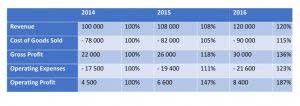
An asset turnover ratio of 1.5 is a strong indicator of a company’s financial health, suggesting efficient use of assets to generate revenue. This ratio indicates a company is effectively leveraging its assets to drive sales and growth. A high fixed asset turnover ratio indicates that a company is using its fixed assets efficiently. In the retail industry, a Online Accounting ratio of 3 to 5 is considered good, as seen in the example of Walmart, which had a total asset turnover ratio of 3.43 in 2020.

What is a Good Asset Turnover Ratio?

To understand whether a company’s ratio is good, compare it to similar businesses in the same industry. This provides context and helps identify whether the company is using its assets effectively relative to its Bookkeeping for Etsy Sellers peers. Hence, we use the average total assets across the measured net sales period in order to align the timing between both metrics. From the asset turnover ratio calculation done, Walmart, Target, AT & T, and Verizon had an asset turnover ratio of 2.29, 1.99, 0.31, and 0.42 respectively. Recall that the asset turnover ratio is most useful when compared across similar companies.
Asset Turnover Ratio vs. Profit Margin
Its total assets were $1 billion at the beginning of the year and $2 billion at the end. It’s also worth noting that the asset turnover ratio can provide bad information without additional context. For example, a company investing heavily in anticipation of rapid growth in the future may exhibit a drop in asset turnover.
The impact of efficient asset management on turnover ratios

Let’s consider two companies, Company A and Company B, operating in the retail industry. Company A has a higher Asset Turnover Ratio of 2.5, indicating that it generates $2.5 in sales for every dollar of assets. On the other hand, Company B has a lower ratio of 1.8, suggesting that it generates $1.8 in sales for every dollar of assets. This comparison highlights the difference in efficiency between the two companies. In summary, interpreting the asset turnover ratio requires considering industry norms, operational context, and the company’s unique circumstances.

Long-term implications: how a healthy ratio affects overall business growth
Companies with strong ratios may review all aspects that generate solid profits or healthy cash flow. FAT only looks at net sales and fixed assets; company-wide expenses are not factored into the equation. In addition, there may be differences in the cash flow between when net sales are collected and when fixed assets are acquired. A technology company like Meta has a significantly smaller fixed asset base than a manufacturing giant like Caterpillar. In this example, Caterpillar’s fixed asset turnover ratio is more relevant and should hold more weight for analysts than Meta’s asset turnover ratio FAT ratio.
- Its total assets were $3 billion at the beginning of the fiscal year and $5 billion at the end.
- A high asset turnover ratio is above 1.5, indicating a company is generating substantial revenue relative to its asset base.
- In addition, there may be differences in the cash flow between when net sales are collected and when fixed assets are acquired.
- One variation on this metric considers only a company’s fixed assets (the FAT ratio) instead of total assets.
- You can locate your net sales number on your income statement (also known as your profit and loss statement).
- The asset turnover ratio formula is equal to net sales divided by the total or average assets of a company.
- We now have all the required inputs, so we’ll take the net sales for the current period and divide it by the average asset balance of the prior and current periods.
- A quick ratio below 1 means that a company’s current liabilities exceed its most liquid assets, which is a sign of financial distress.
- For instance, a ratio of .5 means that each dollar of assets generates 50 cents of sales.
- The average value of the assets for the year is determined using the value of the company’s assets on the balance sheet as of the start of the year and at the end of the year.
- The asset turnover ratio measures operational efficiency, while ROA reflects operational efficiency and profitability.
- Conversely, a lower ratio indicates poor efficiency, which may be due to poor utilization of fixed assets, poor collection methods, or poor inventory management.
One of the primary benefits of asset turnover ratio is that it helps businesses determine how well they are using their assets to generate sales. However, several factors can affect asset turnover ratio, which can make it challenging for companies to improve their efficiency. In this article, we will discuss some of the factors that affect asset turnover ratio and provide insights on how companies can address them. The asset turnover ratio is a useful tool to measure the efficiency of your business. By calculating and interpreting the ratio, you can gain insights into how well you are using your assets to generate revenue. You can also compare your ratio with the industry average, the size and growth stage of your business, and the historical trend to identify your strengths and weaknesses.

